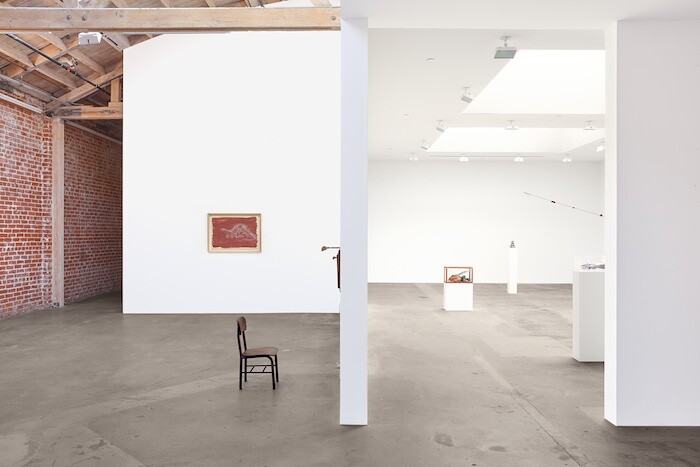There is no more poetic organ than the human heart: a blood-soaked snarl of muscle tissue whose constriction is our literal life force, its cadence—its pulse—has been held accountable for not only bodily function but as the instrument of conscience, intention, love, and courage; a spiritual and corporal engine. The Bengali poet Rabindranath Tagore grasped its virtue on both planes when he mused, “That I want thee, only thee—let my heart repeat without end;”(1) W.H. Auden composed a number of verses over his concern of the amiss desires and capacity of a crooked one. Pre-Columbian Aztecs extracted it, still beating, as a sacrifice to the Sun God; for Roman Catholics, divine love radiates from the Sacred Heart of Jesus—and may it set ablaze all of ours with His love and mercy.(2)
Paul Thek—supermarket attendant, artist, occasional expatriate, diver—was raised Catholic. The work he made in his shortened lifetime, before dying of AIDS-related illness in his mid-fifties in 1988, often displayed a carnal sympathy toward entropy and (its) beauty, intimately embellished, longingly ritualistic—catholic in the comprehensive sense, and anything but devout. Visiting the Capuchin Catacombs in Palermo with his lover Peter Hujar, Thek fell into a macabre exhilaration, wandering through the 8,000 dehydrated bodies on view through windowed caskets. He described his encounters with the embalmed population as being unsaddled by feelings of morbidity or dread: “I opened one [coffin] and picked up what I thought was a piece of paper; it was a piece of dried thigh … It delighted me that bodies could be used to decorate a room, like flowers. We accept our thing-ness intellectually, but the emotional acceptance of it can be a joy…”(3) Studying Antonin Artaud’s punishing architecture of physical theater, the museum became a surrogate for the mausoleum: Thek began making his own, The Tomb, in 1967. This room-sized, simplified pyramid was centered in a plaster cast of the artist’s body, blackened tongue visible, lain in a corner and protected by a fence of wine glasses and handwritten letters, orbited by what came to be known as his “Technical Reliquaries” (1964–67)—candy-pink casts of his limbs and face—and “Meat Pieces” (1963–67)—cross sections of skin and tissue hyper-realistically formed from red wax—each isolated in acrylic vitrines alternatingly colorless or hued electric citrine.
The Tomb eventually went astray, and the artist’s wax body went missing; it is widely believed that it was trashed.1 Gathering Thek’s work is a near-insurmountable task, his oeuvre strewn with such episodes of institutional negligence, while his featherweight works are agitated by efforts at conservation or transportation; as most of his work resides in European collections, a congregation in the US is even more infrequent. So a humbler exhibition at Hannah Hoffman, his first in a commercial gallery in Los Angeles, is very welcome, especially in a city that has produced generations of peers who owe him a significant artistic debt: the easy scrawls in Untitled (Whaddaya Wanna Be a Flower?) (ca. 1986) share a heavy-lidded tease with Raymond Pettibon’s brazen, reduced scenes of the same years; Mike Kelley and Paul McCarthy’s kaleidoscopic infantilism and Jason Rhoades’s relentless, consuming habitats would have looked markedly different had they not had Thek to look to.
A mercury-colored forearm from The Tomb, Untitled (from the series “Technological Reliquaries”) (ca.1966–67) does not rest, its fingers still taut, three of them dipped in the saccharine rose color, the wrist dotted with glass baubles; its Plexiglas case is crowned with a flowing blond wig. Across the room, Untitled (Hand with Ring) (1967) stands naked, without its protective covering, wearing only a coat of psychedelic paint drips. Part of The Tomb’s official history is the work’s unauthorized, but perhaps more established, alternate title: Death of a Hippie.
Mottled with delicate, modest drawings of ink on paper and hand-sized paintings over yellowing newsprint or in ornate frames, their parameters host high spirits and whimsy. Studies of landscapes hang with sketches of studio interiors, while You Cannot Resist My Wave (1979); Dinosaur (Unfinished) (1975); and Untitled (Red Triangles and Squiggles) (1984) illustrate floating, fugitive fantasies.
A monstrous garland of dense, raw clumps, each resembling a loosened heart, is suspended over a corner: Untitled (Meat Cable) (1968–69) parades a series of the romantic, heroic motors on an industrial cord. It is unclear whose flesh these may have been modeled after, but in a room of the artist’s fractured self-replicas, it is conceivable that Thek held a more mystical anatomy than we are designed for, and contained many hearts.
(1) Rabindranath Tagore, “Poem 38” in Gitanjali (London: Dover Publications, 2000), 14. (2) Letter from Sister Mary of the Divine Heart in a letter to Pope Leo XIII, 1899. (3) Gene R. Swenson, “Beneath the Skin,” in ARTnews, 65, no. 2, April 1966, 66.
Harald Falckenberg and Peter Weibel, eds., Paul Thek: Artist’s Artist (Boston: MIT Press, 2009), 29.









